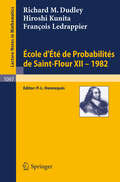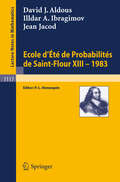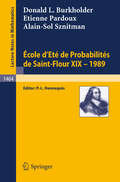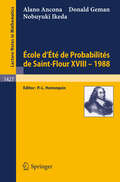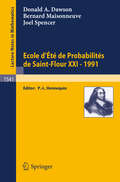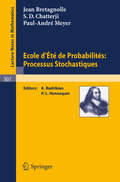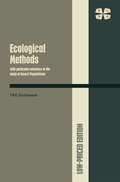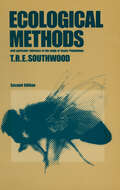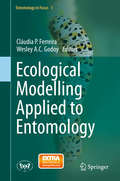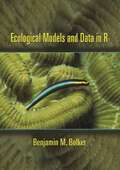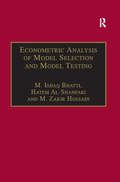- Table View
- List View
Ecole d'Ete de Probabilites de Saint-Flour XII, 1982 (Lecture Notes in Mathematics #1097)
by R. M. Dudley H. Kunita F. LedrappierEcole d'Ete de Probabilites de Saint-Flour XIII, 1983 (Lecture Notes in Mathematics #1117)
by David J. Aldous Illdar A. Ibragimov Jean JacodEcole d'Ete de Probabilites de Saint-Flour XIX - 1989 (Lecture Notes in Mathematics #1464)
by Donald L. Burkholder Etienne Pardoux Alain-Sol SznitmanEcole d'Ete de Probabilites de Saint-Flour XV-XVII, 1985-87 (Lecture Notes in Mathematics #1362)
by Persi Diaconis David Elworthy Hans Föllmer Edward Nelson George Papanicolaou Srinivasa R.S. VaradhanThis volume contains detailed, worked-out notes of six main courses given at the Saint-Flour Summer Schools from 1985 to 1987.
Ecole d'Ete de Probabilites de Saint-Flour XVIII - 1988 (Lecture Notes in Mathematics #1427)
by Alano Ancona Donald Geman Nobuyuki IkedaThis book contains three lectures each of 10 sessions; the first on Potential Theory on graphs and manifolds, the second on annealing and another algorithms for image reconstruction, the third on Malliavin Calculus.
Ecole d'Ete de Probabilites de Saint-Flour XX - 1990 (Lecture Notes in Mathematics #1527)
by Mark I. Freidlin Jean-Francois Le GallEcole d'Ete de Probabilites de Saint-Flour XXI - 1991 (Lecture Notes in Mathematics #1541)
by Donald A. Dawson Bernard Maisonneuve Joel SpencerEcole d'Ete de Probabilites: Processus Stochastiques (Lecture Notes in Mathematics #307)
by J. L. Bretagnolle S. D. Chatterji P.-A. MeyerEcological and Evolutionary Modelling (SpringerBriefs in Ecology)
by Cang Hui Pietro Landi Henintsoa Onivola Minoarivelo Andriamihaja RamanantoaninaEcology studies biodiversity in its variety and complexity. It describes how species distribute and perform in response to environmental changes. Ecological processes and structures are highly complex and adaptive. In order to quantify emerging ecological patterns and investigate their hidden mechanisms, we need to rely on the simplicity of mathematical language. Ecological patterns are emerging structures observed in populations, communities and ecosystems. Elucidating drivers behind ecological patterns can greatly improve our knowledge of how ecosystems assemble, function and respond to change and perturbation. Mathematical ecology has, thus, become an important interdisciplinary research field that can provide answers to complex global issues, such as climate change and biological invasions.The aim of this book is to (i) introduce key concepts in ecology and evolution, (ii) explain classic and recent important mathematical models for investigating ecological and evolutionary dynamics, and (iii) provide real examples in ecology/biology/environmental sciences that have used these models to address relevant issues. Readers are exposed to the key concepts, frameworks, and terminology in the studies of ecology and evolution, which will enable them to ask the correct and relevant research questions, and frame the questions using appropriate mathematical models.
Ecological Methods: With Particular Reference to the Study of Insect Populations
by T.R. Southwoodthe virtual impossibility of extracting the many different species from a habitat with equal efficiency by a single method (e.g. Nef, 1960). 1.1 Population estimates Population estimates can be classified into a number of different types; the most convenient classification is that adopted by Morris (1955), although he used the terms somewhat differently in a later paper (1960). 1.1.1 Absolute and related estimates The animal numbers may be expressed as a density per unit area of the ground of the habitat. Such estimates are given by nearest neighbour and related techniques (Chapter 2), marking and recapture (Chapter 3), by sampling a known fraction of the habitat (Chapter 4-6) and by removal sampling and random walk techniques (Chapter 7). Absolute population The number of animals per unit area (e.g. hectare, acre). It is almost impossible to construct a budget or to study mortality factors without the conversion of population estimates to absolute figures, for not only do insects often move from the plant to the soil at different developmental stages, but the amount of plant material is itself always changing. The importance of obtaining absolute estimates cannot be overemphasized.
Ecological Modelling Applied to Entomology (Entomology in Focus #1)
by Cláudia P. Ferreira Wesley A.C GodoyInsects, when studied from the ecological perspective, provide a great opportunity for scientific studies emphasizing population theory. The simple fact of being successful organisms for their ability to colonize different habitats or even for their high reproductive potential, increases the interest of ecologists in conducting studies focused on population and community level. Mathematical models are powerful tools that can capture the essence of many biological systems and investigate ecological patterns associated to ecological stability dependent on endogenous and exogenous factors. This proposal comes from the idea of adding experiences of researchers interested in working at the interface between mathematical and computation theory and problems centered on entomology, showing how mathematical modelling can be an important tool for understanding population dynamics, behavior, pest management, spatial structure and conservation.
Ecological Models and Data in R
by Benjamin M. BolkerEcological Models and Data in R is the first truly practical introduction to modern statistical methods for ecology. In step-by-step detail, the book teaches ecology graduate students and researchers everything they need to know in order to use maximum likelihood, information-theoretic, and Bayesian techniques to analyze their own data using the programming language R. Drawing on extensive experience teaching these techniques to graduate students in ecology, Benjamin Bolker shows how to choose among and construct statistical models for data, estimate their parameters and confidence limits, and interpret the results. The book also covers statistical frameworks, the philosophy of statistical modeling, and critical mathematical functions and probability distributions. It requires no programming background--only basic calculus and statistics. Practical, beginner-friendly introduction to modern statistical techniques for ecology using the programming language R Step-by-step instructions for fitting models to messy, real-world data Balanced view of different statistical approaches Wide coverage of techniques--from simple (distribution fitting) to complex (state-space modeling) Techniques for data manipulation and graphical display Companion Web site with data and R code for all examples
Ecological Models and Data in R
by Benjamin M. BolkerEcological Models and Data in R is the first truly practical introduction to modern statistical methods for ecology. In step-by-step detail, the book teaches ecology graduate students and researchers everything they need to know in order to use maximum likelihood, information-theoretic, and Bayesian techniques to analyze their own data using the programming language R. Drawing on extensive experience teaching these techniques to graduate students in ecology, Benjamin Bolker shows how to choose among and construct statistical models for data, estimate their parameters and confidence limits, and interpret the results. The book also covers statistical frameworks, the philosophy of statistical modeling, and critical mathematical functions and probability distributions. It requires no programming background--only basic calculus and statistics. Practical, beginner-friendly introduction to modern statistical techniques for ecology using the programming language R Step-by-step instructions for fitting models to messy, real-world data Balanced view of different statistical approaches Wide coverage of techniques--from simple (distribution fitting) to complex (state-space modeling) Techniques for data manipulation and graphical display Companion Web site with data and R code for all examples
The Ecology, Exploitation and Conservation of River Turtles
by Don Moll Edward O. MollThe underlying theme of this book is that a widespread, taxonomically diverse group of animals, important both from ecological and human resource perspectives, remains poorly understood and in delcine, while receiving scant attention from the ecological and conservation community. This volume proposes a comprehensive overview of the world's river turtles' ecology, conservation, and management. It begins with a categorization of taxa which inhabit flowing water habitats followed by information on their evolutionary and physical diversity and biogeography. Within the framework of ecology, the authors discuss the composition of river turtle communities in different types of lotic habitats and regions, population dynamics, movements, reproductive characteristics and behavior, predators, and feeding relationships. In a conservation and management section, the authors identify and evaluate the nature and intensity of factors which threaten river turtle survival--almost all of which involve direct human exploitation or indirect effects of human induced habitat alteration and degradation. They then list and evaluate the various schemes which have been proposed or employed to halt declines and restore populations, and make recommendations for future management plans for specific species and regions. In closing, they state their viewpoint concerning future research directions and priorities, and an evaluation of future prospects for survival of the world's river turtle species.
ECOMath 1 Mathematik für Wirtschaftswissenschaftler (Springer-Lehrbuch)
by Hans M. DietzBasierend auf seinen Vorlesungszyklen an der Universität Paderborn, vermittelt der Autor die mathematischen Kenntnisse, die für ein erfolgreiches Bachelor- und Master-Studium in den Wirtschaftswissenschaften und verwandten Studiengängen unerlässlich sind. Band I (von 3 Bänden) behandelt vor allem Methoden der eindimensionalen reellen Analysis mit ökonomischen Anwendungen. ECOMath will zeigen, wie Mathematik auf hohem Niveau schnell und effizient in der Ökonomie angewendet wird.
ECOMath 2 Mathematik für Wirtschaftswissenschaftler (Springer-Lehrbuch)
by Hans M. DietzBasierend auf den Erfahrungen des Autors mit Vorlesungen zur „Mathematik für Wirtschaftswissenschaftler" vermittelt der Band die mathematischen Kenntnisse, die für das Bachelor- und Master-Studium unerlässlich sind. Band 2 (von 3 Bänden) behandelt vor allem Methoden der linearen Algebra, Grundlagen der linearen Optimierung mit ökonomischen Anwendungen und macht einen Ausflug in die mathematische Modellierung. Der Einstieg ist mit geringen schulischen Vorkenntnissen möglich. Farbige Abbildungen und Übersichten visualisieren den Stoff.
Econometric Advances in Spatial Modelling and Methodology: Essays in Honour of Jean Paelinck (Advanced Studies in Theoretical and Applied Econometrics #35)
by Daniel A. Griffith C. Amrhein Jean-Marie HuriótThe purpose of models is not to fit the data but to sharpen the questions. S. Karlin, 11th R. A. Fisher Memorial Lecture, Royal Society, 20 April 1983 We are proud to offer this volume in honour of the remarkable career of the Father of Spatial Econometrics, Professor Jean Paelinck, presently of the Tinbergen Institute, Rotterdam. Not one to model solely for the sake of modelling, the above quotation nicely captures Professor Paelinck's unceasing quest for the best question for which an answer is needed. His FLEUR model has sharpened many spatial economics and spatial econometrics questions! Jean Paelinck, arguably, is the founder of modem spatial econometrics, penning the seminal introductory monograph on this topic, Spatial Econometrics, with Klaassen in 1979. In the General Address to the Dutch Statistical Association, on May 2, 1974, in Tilburg, "he coined the term [spatial econometrics] to designate a growing body of the regional science literature that dealt primarily with estimation and testing problems encountered in the implementation of multiregional econometric models" (Anselin, 1988, p. 7); he already had introduced this idea in his introductory report to the 1966 Annual Meeting of the Association de Science Regionale de Langue Fran~aise.
Econometric Analysis of Carbon Markets: The European Union Emissions Trading Scheme and the Clean Development Mechanism
by Julien ChevallierThrough analysis of the European Union Emissions Trading Scheme (EU ETS) and the Clean Development Mechanism (CDM), this book demonstrates how to use a variety of econometric techniques to analyze the evolving and expanding carbon markets sphere, techniques that can be extrapolated to the worldwide marketplace. It features stylized facts about carbon markets from an economics perspective, as well as covering key aspects of pricing strategies, risk and portfolio management.
Econometric Analysis of Count Data
by Rainer WinkelmannThe book provides an up-to-date survey of statistical and econometric techniques for the analysis of count data, with a focus on conditional distribution models. The book starts with a presentation of the benchmark Poisson regression model. Alternative models address unobserved heterogeneity, state dependence, selectivity, endogeneity, underreporting, and clustered sampling. Testing and estimation is discussed. Finally, applications are reviewed in various fields.
Econometric Analysis of Count Data
by Rainer WinkelmannThis monograph deals with econometric models for the analysis of event counts. The interest of econometricians in this class of models has started in the mid-eighties. After more than one decade of intensive research, the litera ture has reached a level of maturity that calls for a systematic and accessible exposition of the main results and methods. Such an exposition is the aim of the book. Count data models have found their way into the curricula of micro-econometric classes and are available on standard computer software. The basic methods have been used in countless applications in fields such as labor economics, health economics, insurance economics, urban economics, and economic demography, to name but a few. Other, more recent, methods are poised to become standard tools soon. While the book is oriented towards the empirical economists and applied econometrician, it should be useful to statisticians and biometricians as well. A first edition of this book was published in 1994 under the title "Count Data Models - Econometric Theory and an Application to Labor Mobility" . While this edition keeps the character and broad organization of this first edition, and its emphasis on combining a summary of the existing literature with several new results and methods, it is substantially revised and enlarged. Many parts have been completely rewritten and several new sections have New sections include: count data models for dependent processes; been added.
Econometric Analysis of Count Data
by Rainer WinkelmannThe primary objective of this book is to provide an introduction to the econometric modeling of count data for graduate students and researchers. It should serve anyone whose interest lies either in developing the field fur ther, or in applying existing methods to empirical questions. Much of the material included in this book is not specific to economics, or to quantita tive social sciences more generally, but rather extends to disciplines such as biometrics and technometrics. Applications are as diverse as the number of congressional budget vetoes, the number of children in a household, and the number of mechanical defects in a production line. The unifying theme is a focus on regression models in which a dependent count variable is modeled as a function of independent variables which mayor may not be counts as well. The modeling of count data has come of age. Inclusion of some of the fundamental models in basic textbooks, and implementation on standard computer software programs bear witness to that. Based on the standard Poisson regression model, numerous extensions and alternatives have been developed to address the common challenges faced in empirical modeling (unobserved heterogeneity, selectivity, endogeneity, measurement error, and dependent observations in the context of panel data or multivariate data, to name but a few) as well as the challenges that are specific to count data (e. g. , over dispersion and underdispersion).
Econometric Analysis of Count Data
by Rainer WinkelmannGraduate students and researchers are provided with an up-to-date survey of statistical and econometric techniques for the analysis of count data, with a focus on conditional distribution models. Proper count data probability models allow for rich inferences, both with respect to the stochastic count process that generated the data, and with respect to predicting the distribution of outcomes. The book starts with a presentation of the benchmark Poisson regression model. Alternative models address unobserved heterogeneity, state dependence, selectivity, endogeneity, underreporting, and clustered sampling. Testing and estimation is discussed from frequentist and Bayesian perspectives. Finally, applications are reviewed in fields such as economics, marketing, sociology, demography, and health sciences. The fourth edition contains several new sections, for example on nonnested hurdle models, quantile regression and on software. Many other sections have been entirely rewritten and extended.
Econometric Analysis of Model Selection and Model Testing
by M. Ishaq Bhatti Hatem Al-ShanfariIn recent years econometricians have examined the problems of diagnostic testing, specification testing, semiparametric estimation and model selection. In addition researchers have considered whether to use model testing and model selection procedures to decide the models that best fit a particular dataset. This book explores both issues with application to various regression models, including the arbitrage pricing theory models. It is ideal as a reference for statistical sciences postgraduate students, academic researchers and policy makers in understanding the current status of model building and testing techniques.
Econometric Analysis of Model Selection and Model Testing
by M. Ishaq Bhatti Hatem Al-ShanfariIn recent years econometricians have examined the problems of diagnostic testing, specification testing, semiparametric estimation and model selection. In addition researchers have considered whether to use model testing and model selection procedures to decide the models that best fit a particular dataset. This book explores both issues with application to various regression models, including the arbitrage pricing theory models. It is ideal as a reference for statistical sciences postgraduate students, academic researchers and policy makers in understanding the current status of model building and testing techniques.
